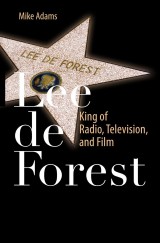Details

Lee de Forest
King of Radio, Television, and Film|
42,79 € |
|
| Verlag: | Copernicus |
| Format: | |
| Veröffentl.: | 17.10.2011 |
| ISBN/EAN: | 9781461404187 |
| Sprache: | englisch |
| Anzahl Seiten: | 553 |
Dieses eBook enthält ein Wasserzeichen.
Beschreibungen
The life-long inventor, Lee de Forest invented the three-element vacuum tube used between 1906 and 1916 as a detector, amplifier, and oscillator of radio waves. Beginning in 1918 he began to develop a light valve, a device for writing and reading sound using light patterns. While he received many patents for his process, he was initially ignored by the film industry. In order to promote and demonstrate his process he made several hundred sound short films, he rented space for their showing; he sold the tickets and did the publicity to gain audiences for his invention. Lee de Forest officially brought sound to film in 1919. <i>Lee De Forest: King of Radio, Television, and Film</i> is about both invention and early film making; de Forest as the scientist and producer, director, and writer of the content. This book tells the story of de Forest’s contribution in changing the history of film through the incorporation of sound. The text includes primary source historical material, U.S. patents and richly-illustrated photos of Lee de Forest’s experiments. Readers will greatly benefit from an understanding of the transition from silent to audio motion pictures, the impact this had on the scientific community and the popular culture, as well as the economics of the entertainment industry.
<p>Chapter 1 Born to Invent.- The Century of the Inventor.- Toward Communication Without Wires.- Inventing the Motion Picture.- Enter Lee de Forest.- Toward the New Century.- Chapter 2 The Race for Wireless.- The Significance of Marconi.- De Forest’s Early Career.- Seeking a Better Detector.- The Complex Wireless Business.- A Silent Film Industry Emerges.- Chapter 3 The Meaning of the Audion.- The Dawn of Modern Electronics.- De Forest Creates the Audion.- Broadcasting’s Pioneers.- De Forest as an Early Broadcaster.- De Forest’s Complex Love Lives.- Chapter 4 California Days.- Film Finds Language and Locations.- De Forest and the Law.- Selling the Audion.- The High Bridge Broadcasts.- The Watershed Year 1920.- Chapter 5 Radio’s Arrival.- The RCA Agreements.- Defining American Radio Broadcasting.- Hugo Gernsback and Radio News.- Creating a Radio Audience.- Radio Technology Matures.- Chapter 6 Phonofilm, the Promise.- De Forest’s Inspiration.- Inventing Phonofilm.- The Case Connection.- The Arc of Family.- The Silent Film as Mature Medium.- Chapter 7 Phonofilm, the Realization.- Case is Impatient.- De Forest Introduces Phonofilm.- The Business of Phonofilm.- De Forest Diversions.- What the Phonofilms Say.- Chapter 8 Phonofilm, the Rejection.- A Deaf Ear to Phonofilm.- Death by Vitaphone.- The End of Mary.- The Industry and the Public Adapt.- Sound-On-Film Technology Wars.- Chapter 9 Phonofilm, the Lawyers.- The Fox-Case Suit.- The Final Days of Phonofilm.- The Loneliness of Lee.- Hollywood Happiness.- Old Patents and New Awards.- Chapter 10 Lesson and Legacy.- The Father of Radio.- Awards and Accolades.- Other Opinions.- And In The End.- The Significance of Lee De Forest.</p>
Mike Adams has been a radio personality and a film maker. Currently he is a professor of radio, television, and film at San Jose State University, where he has been a department chair and an associate dean. As a researcher and writer of broadcast and early technology history, he created two award-winning documentaries for PBS, “Radio Collector,” and “Broadcasting’s Forgotten Father.” He has had published numerous articles and three books, the most recent of which is <i>Charles Herrold, Inventor of Radio Broadcasting</i>. More information about the author and his work can be found at www.mikeadams.org and www.leedeforest.org
<p>Lee de Forest, Yale doctorate and Oscar winner, gave voice to the radio and the motion picture. Yet by the 1930s, after the radio and the Talkies were regular features of American life, Lee de Forest had seemingly lost everything. Why? Why didn’t he receive the recognition and acclaim he sought his entire life until years later in 1959, when he was awarded an Oscar?</p><p>A lifelong innovator, Lee de Forest invented the three-element vacuum tube which he developed between 1906 and 1916 as a detector, amplifier, and oscillator of radio waves. As early as 1907, he was broadcasting music programming. In 1918, he began to develop a system for recording and playing back sound by using light patterns on motion picture film. In order to promote and demonstrate his process he made hundreds of short sound films, found theatres for their showing, and issued publicity to gain audiences for his invention. While he received many patents for this technology, he was ignored by the film industry.</p><p><i>Lee de Forest, King of Radio, Television, and Film</i> is about the process of invention—how inventors really get ideas and how every inventor learns that they must know the work of those who came before, and why the myth of the lone inventor and the “Aha! moment” is largely a fiction.</p><p>Through his inventions, Lee de Forest made possible the mass entertainment media we enjoy today. This is his story.</p>
<p>Clarifies the debate over the invention of sound in movies</p><p>Coverage of the history and progress of audio technology in cinema</p><p>Demonstrates how scientific technical standards are derived and integrated into the film industry</p><p>Includes primary source historical material and richly-illustrated photos of Lee de Forest’s experiments</p><p>Includes supplementary material: sn.pub/extras</p>


















